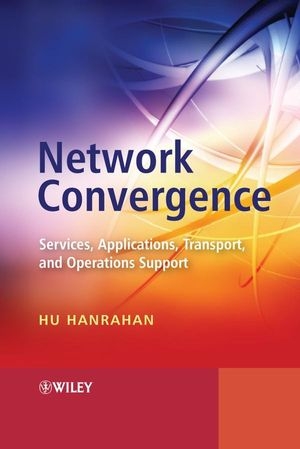
Network Convergence
John Wiley & Sons Inc (Verlag)
978-0-470-02441-6 (ISBN)
Network Convergence:
Gives comprehensive coverage of packet multimedia, enterprise networks, third generation mobile communications, OSA/Parlay and developments in fixed networks.
Gives an integrated view of diverse information and communications systems and technology through a common NGN Framework.
Delves into protocols, APIs and software processes for supporting services and applications in advanced networks.
Discusses a variety of applications of telecommunications supporting IT and IT enhanced by communications.
Follows developments in operations support systems standards and links these to next generation networks.
Includes a wealth of examples, use cases, tables and illustrations that help reinforce the material for students and practitioners.
Features an accompanying website with PowerPoint presentations, glossary, web references, tutorial problems, and 'learn more' pages.
This essential reference guide will prove invaluable to advanced undergraduate and graduate students, academics and researchers. It will also be of interest to professionals working for telecommunications network operators, equipment vendors, telecoms regulators, and engineers who wish to further their knowledge of next generation networks.
Hu Hanrahan is Professor of Communications Engineering and Director of the Centre for Telecommunications Access and Services at the University of the Witswatersrand. He is a graduate of the University of the Witswatersrand, from where he also received his Doctorate. He has extensive experience of teaching in the subject area and is also active as consultant for a large number of companies and public utilities. His academic publication record is extensive over many aspects of communications technology.
Preface. Acknowledgments.
Conventions.
Companion Website.
Abbreviations.
Principal Graphic Symbols.
1 Setting the Context for Evolution and Convergence of Networks.
1.1 Historical Background to Present Networks.
1.2 Defining Present State Using Reference Models.
1.3 Evolution and Convergence.
1.4 The Next GenerationNetwork Concept.
1.5 Conclusion.
2 A Framework for Examining Next Generation Networks.
2.1 Characteristics of Evolving Networks.
2.2 Dealing with Complexity.
2.3 Framework for EvolvingNetworks.
2.4 Examples of Application of Framework.
2.5 Conclusion.
3 Software Methodologies for Converged Networks and Services.
3.1 Development of Software Methodologies for ICT.
3.2 Software Processes in the NGN Framework.
3.3 High-level Analysis and DesignMethods.
3.4 Enterprise and Business Modelling Notation.
3.5 Object and Data Definition Languages.
3.6 Dynamic Modelling Notations.
3.7 Component and Interface Notations.
3.8 Distributed Systems.
3.9 Creating a Unified Framework.
4 An NGN: the Managed Voice over IP Network.
4.1 Development of Packet Multimedia Standards.
4.2 Requirements on a Managed Voice Network.
4.3 Properties of Packetised Voice.
4.4 General Concepts of Multimedia Communications.
4.5 Signalling Plane for Packet Multimedia.
4.6 The H.323 Suite.
4.7 Media Gateway Functions and Control.
4.8 Multimedia Communications Based on SIP.
4.9 Supplementary Services in Packet Telephony.
4.10 ITU-T Evolutionary Protocols: BICC.
4.11 Voice on the Internet.
4.12 Conclusion.
5 Integrated Enterprise ICT Systems.
5.1 Drivers and Requirements.
5.2 Contributions to Convergence.
5.3 Network Level Convergence.
5.4 Application and Service Level Convergence.
5.5 Conclusions.
6 Legacies and Lessons: Broadband ISDN, TINA and TIPHON.
6.1 Learning from History.
6.2 The Broadband ISDN.
6.3 TINA Architecture.
6.4 Business Model and Reference Points.
6.5 TINA Service Architecture.
6.6 Network Resource Architecture.
6.7 Lessons from TINA for NGNs.
6.8 TIPHON.
6.9 Conclusion.
7 Important NGNs: Third Generation Mobile Communication Systems.
7.1 Architectural Concepts.
7.2 Mobile Communication System Evolution.
7.3 Services in the CS Domain.
7.4 Packet-switched Domain: GPRS-based Systems.
7.5 IP Multimedia Subsystem.
7.6 Conclusion.
8 Opening the Network using Application Programming Interfaces.
8.1 Closed Network Evolution.
8.2 Opening the Network.
8.3 The OSA/Parlay Architecture.
8.4 Framework Interfaces and Use Cases.
8.5 The OSA/Parlay Gateway.
8.6 Communication-orientatedUse Cases.
8.7 ParlayXWeb Services.
8.8 OSA/Parlay API Implementation Issues.
8.9 Other Approaches to Open Networks.
8.10 Conclusion.
9 Operations Support Systems.
9.1 Relationship of OSS/BSS to ICT Systems.
9.2 Evolution of OSS/BSS.
9.3 The Telecommunications Operations Map.
9.4 Enhancement of the TOM: eTOM.
9.5 New Generation OSS.
9.6 Conclusion.
10 Migration from Legacy to Next Generation Networks.
10.1 Retrospect.
10.2 Reflecting on Evolution and Convergence.
10.3 TechnologyMigration.
10.4 Is There a Target NGN?
10.5 Managing Complexity: Avoiding Pitfalls.
10.6 A Last Word.
Glossary.
References
Index.
| Erscheint lt. Verlag | 2.4.2007 |
|---|---|
| Verlagsort | New York |
| Sprache | englisch |
| Maße | 173 x 252 mm |
| Gewicht | 1057 g |
| Themenwelt | Technik ► Elektrotechnik / Energietechnik |
| ISBN-10 | 0-470-02441-0 / 0470024410 |
| ISBN-13 | 978-0-470-02441-6 / 9780470024416 |
| Zustand | Neuware |
| Haben Sie eine Frage zum Produkt? |
aus dem Bereich



